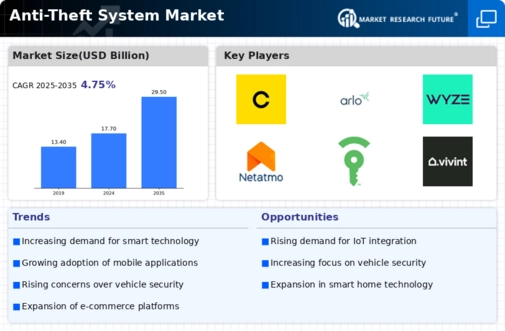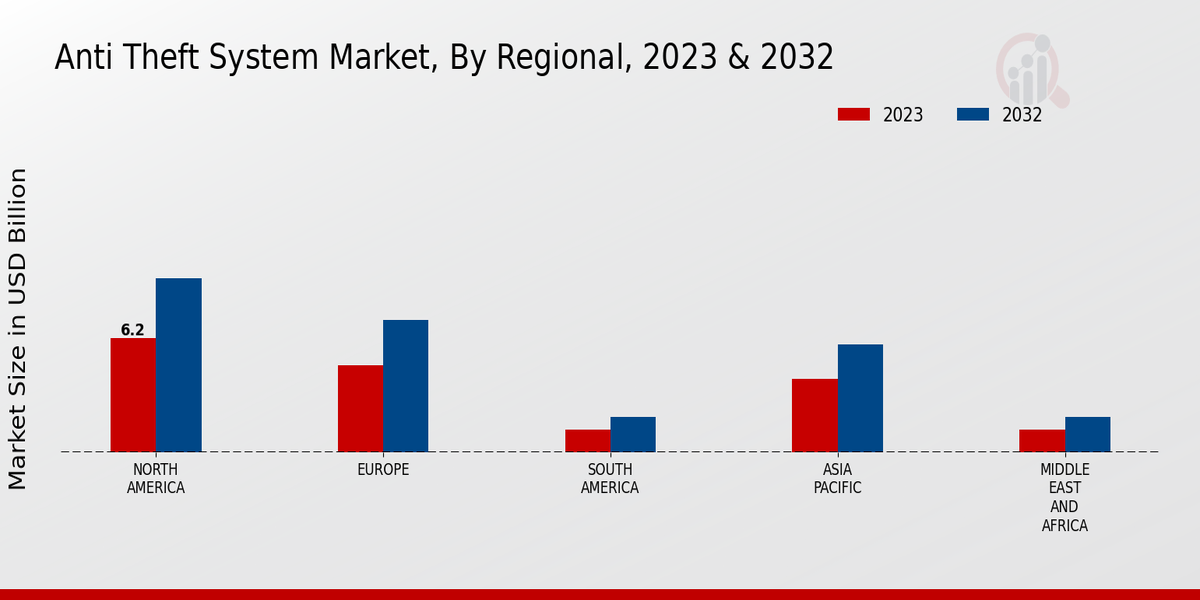Rising Crime Rates
The Global Anti-Theft System Market Industry is experiencing growth due to increasing crime rates worldwide. According to government statistics, property crimes have surged in urban areas, prompting consumers and businesses to invest in anti-theft solutions. In 2024, the market is projected to reach 17.7 USD Billion, driven by heightened demand for security systems. This trend is particularly evident in regions with high burglary rates, where the adoption of advanced anti-theft technologies, such as smart locks and surveillance systems, is becoming commonplace. As crime rates continue to rise, the need for effective anti-theft measures is likely to escalate, further propelling market growth.
Market Growth Projections
The Global Anti-Theft System Market Industry is poised for substantial growth, with projections indicating a market value of 17.7 USD Billion in 2024 and an anticipated increase to 29.5 USD Billion by 2035. This growth trajectory suggests a compound annual growth rate of 4.75% from 2025 to 2035. The increasing adoption of advanced security technologies, coupled with rising crime rates and growing consumer awareness, is likely to drive this expansion. The market's evolution reflects a broader trend towards enhanced security measures across various sectors, indicating a robust future for anti-theft systems.
Technological Advancements
Technological innovations are significantly influencing the Global Anti-Theft System Market Industry. The integration of IoT and AI in security systems enhances their effectiveness and user-friendliness. For instance, smart security cameras equipped with facial recognition capabilities are gaining traction among consumers. These advancements not only improve security but also provide real-time monitoring and alerts, appealing to a tech-savvy demographic. As the market evolves, the introduction of new technologies is expected to drive growth, with projections indicating a market value of 29.5 USD Billion by 2035. The continuous evolution of technology suggests that the anti-theft systems will become increasingly sophisticated, catering to diverse consumer needs.
Regulatory Support and Standards
Regulatory frameworks and standards play a crucial role in shaping the Global Anti-Theft System Market Industry. Governments worldwide are implementing stringent regulations to enhance security measures across various sectors. For example, mandates for the installation of anti-theft systems in commercial establishments are becoming more common. This regulatory support not only encourages businesses to adopt security solutions but also fosters innovation within the industry. As compliance becomes a priority, manufacturers are likely to invest in developing advanced anti-theft technologies, further driving market growth. The alignment of regulations with industry standards is expected to create a conducive environment for the expansion of the anti-theft system market.
Growing Awareness of Security Solutions
There is a notable increase in consumer awareness regarding security solutions, which is positively impacting the Global Anti-Theft System Market Industry. Educational campaigns and government initiatives aimed at promoting safety have led to a heightened understanding of the importance of anti-theft systems. As individuals and businesses recognize the potential financial losses associated with theft, they are more inclined to invest in preventive measures. This growing awareness is reflected in the increasing sales of anti-theft devices, which are expected to contribute to a compound annual growth rate of 4.75% from 2025 to 2035. The proactive approach towards security is likely to sustain market momentum.
Increased Demand from E-commerce Sector
The rise of the e-commerce sector is significantly influencing the Global Anti-Theft System Market Industry. With the surge in online shopping, retailers are increasingly concerned about theft and fraud, prompting them to invest in robust anti-theft solutions. The need for secure payment systems and inventory protection has led to the adoption of advanced security technologies. As e-commerce continues to expand, the demand for anti-theft systems is likely to grow, contributing to the overall market value. This trend indicates that the anti-theft system market will remain resilient, adapting to the evolving needs of the retail sector.






















